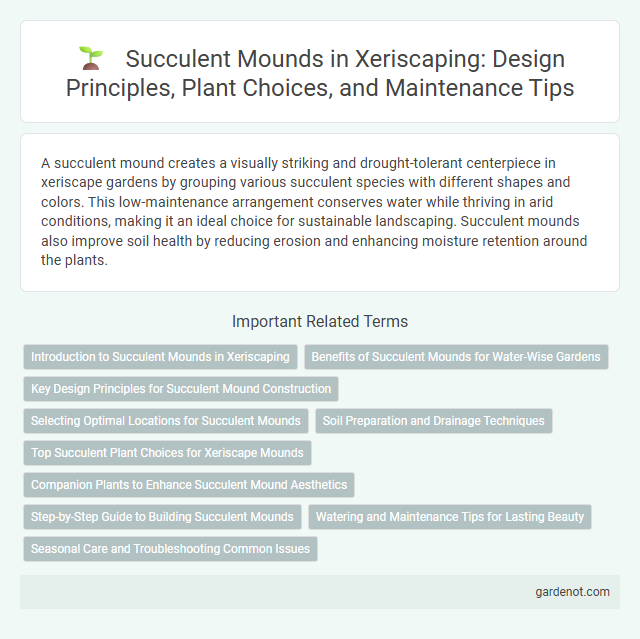A succulent mound creates a visually striking and drought-tolerant centerpiece in xeriscape gardens by grouping various succulent species with different shapes and colors. This low-maintenance arrangement conserves water while thriving in arid conditions, making it an ideal choice for sustainable landscaping. Succulent mounds also improve soil health by reducing erosion and enhancing moisture retention around the plants.
Introduction to Succulent Mounds in Xeriscaping
Succulent mounds serve as an efficient xeriscaping feature by maximizing water conservation through drought-tolerant plants like agave, echeveria, and sedum. These dense, rounded formations reduce soil erosion and enhance microclimates by retaining moisture and minimizing evaporation. Integrating succulent mounds improves landscape resilience while adding architectural interest and vibrant textures in arid garden designs.
Benefits of Succulent Mounds for Water-Wise Gardens
Succulent mounds enhance water-wise gardens by significantly reducing irrigation needs through their drought-tolerant nature. Their dense, fleshy leaves store water efficiently, promoting conservation in arid landscapes. This low-maintenance design also prevents soil erosion while offering year-round visual appeal with varied textures and colors.
Key Design Principles for Succulent Mound Construction
Succulent mound construction prioritizes well-draining soil mixed with coarse sand and gravel to prevent water retention and root rot. Strategic placement of succulents based on their water and light requirements ensures healthy growth and aesthetic appeal. Incorporating terraces or slopes enhances drainage while creating visual interest and accessibility in xeriscape designs.
Selecting Optimal Locations for Succulent Mounds
Succulent mounds thrive best in well-draining, sandy or rocky soils with full sun exposure for at least six hours daily, minimizing the risk of root rot and promoting healthy growth. Positioning succulent mounds on gentle slopes enhances water runoff, preventing water accumulation that can damage the plants. Avoid low-lying areas prone to frost pockets or excessive moisture to ensure durability and longevity of the succulent mound.
Soil Preparation and Drainage Techniques
Succulent mound soil preparation requires well-draining, gritty soil composed of sand, perlite, and organic matter to prevent root rot and ensure optimal moisture retention. Incorporating coarse materials like gravel or pumice improves aeration and facilitates rapid water runoff, crucial for succulents' drought tolerance. Elevating the planting site into a mound enhances drainage, reducing water accumulation around roots and promoting healthy growth in xeriscape designs.
Top Succulent Plant Choices for Xeriscape Mounds
Succulent mounds thrive with top choices like Agave, Aloe, and Echeveria, which offer drought tolerance and striking textures ideal for xeriscape landscapes. These plants require minimal water, making them perfect for water-efficient gardening in arid regions. Incorporating Sedum and Crassula enhances visual diversity while maintaining easy maintenance and soil erosion control on mounded terrain.
Companion Plants to Enhance Succulent Mound Aesthetics
Companion plants such as lavender, ornamental grasses, and sedum varieties enhance succulent mound aesthetics by providing contrasting textures and colors that complement the fleshy leaves of succulents. Drought-tolerant herbs like rosemary and thyme offer fragrant foliage and natural pest deterrence, promoting a healthier succulent mound environment. Integrating low-growing ground covers like creeping thyme or ice plant also helps retain soil moisture and prevent erosion while enriching the visual appeal.
Step-by-Step Guide to Building Succulent Mounds
Creating a succulent mound begins with selecting hardy, drought-tolerant succulent varieties such as echeveria, sedum, and agave that thrive in xeriscape gardens. Prepare the soil by ensuring excellent drainage using a mix of coarse sand, perlite, and cactus potting soil to prevent root rot and promote healthy growth. Layer plants from tallest to shortest, positioning larger species at the center and cascading smaller succulents around the edges for a visually appealing, water-efficient landscape feature.
Watering and Maintenance Tips for Lasting Beauty
Succulent mounds thrive with minimal watering, typically requiring irrigation only once every two to three weeks during dry periods, ensuring soil is well-drained to prevent root rot. Maintenance involves removing dead leaves and periodically checking for pests like aphids or mealybugs to sustain plant health. Applying a light layer of mulch helps retain moisture while reducing weed growth, promoting lasting beauty with efficient water use.
Seasonal Care and Troubleshooting Common Issues
Succulent mounds thrive with seasonal care that includes adjusting watering frequency to prevent root rot during wet months and providing increased sunlight exposure in winter to support growth. Common issues such as mold, pests like mealybugs, and sunburn can be mitigated by ensuring proper drainage, using insecticidal soap, and gradually acclimating plants to intense sunlight. Regularly inspecting plant health and adapting care routines based on seasonal changes promotes robust succulent mound development in xeriscape landscapes.
Succulent mound Infographic

 gardenot.com
gardenot.com